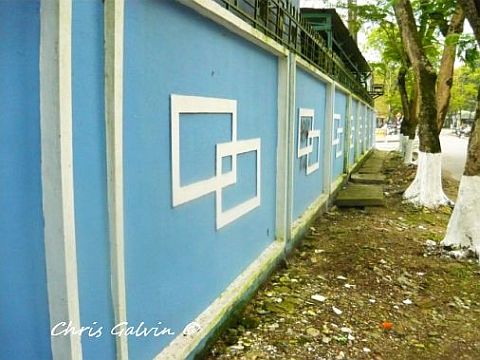
Courtyard Walls
On Hue's busy main streets, most storefronts are wide open, and the merchandise spills out onto the sidewalks. To get into the shops, customers must negotiate their way around parked motorbikes. The quiet side streets are a different world. Schools, homes and other buildings are often hidden behind courtyard walls. Some are moss-covered or have raised designs or small holes cut into them as part of their design. Many illustrate Hue's imperial history, or display the French Colonial architecture so common in the city. This blue and white wall surrounds some buildings on Ngo Quyen Street.
|
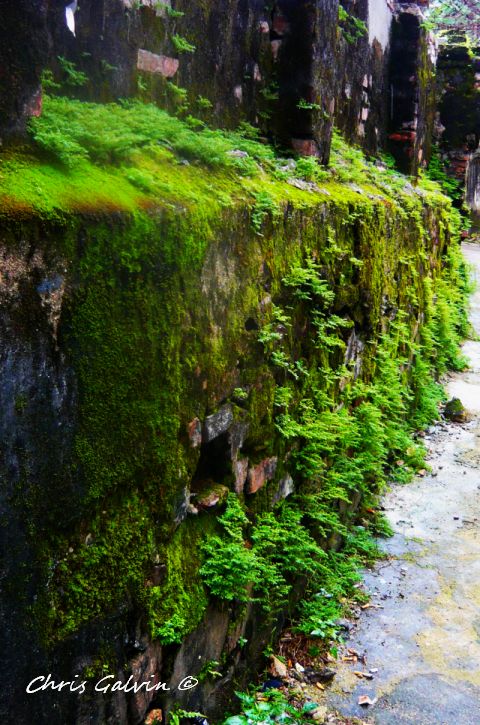
Walls of Moss
Lichen and ferns
lichen and ferns
flourish upon the alley walls
I never cease to be fascinated with this wall of moss and ferns in my alley. Though I walk or ride past it up to a dozen times a day, I can't resist taking yet another photo each time I notice something new: a turn of leaf, a tiny flower inside a dark niche, the way the light falls at different times of day. I've taken dozens of photographs of this wall, and the neighbours must surely think I'm crazy by now. (They may be right…)
|
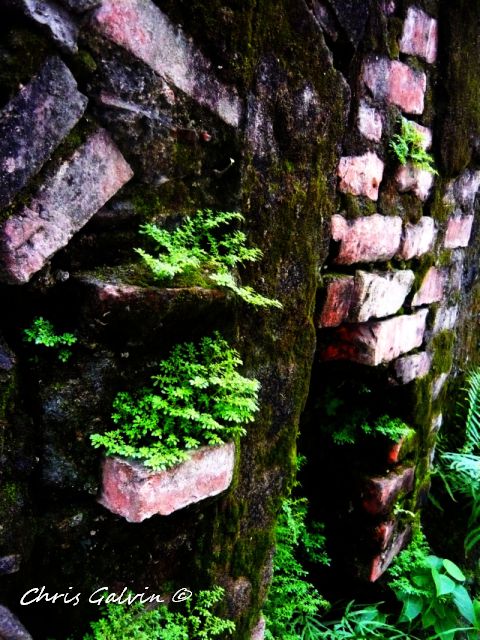
Walls of Moss 2
|
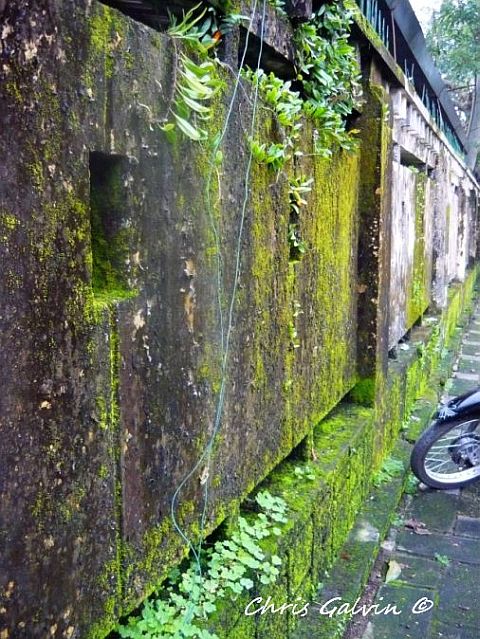
Courtyard walls 2 Mossy walls abound in Hue. This one is on Hai Ba Trung Street, across from a restaurant where my husband and I eat lunch when we don't want to prepare our own. |
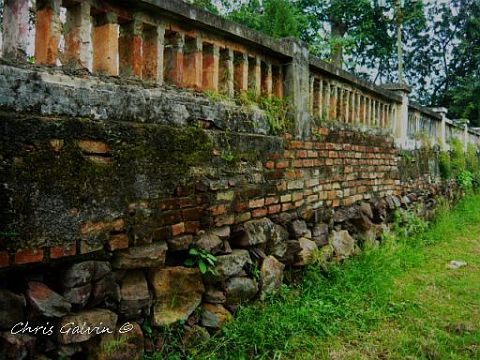
Retaining Wall at Tinh Tam Lake
Lake Tinh Tam was once just a pond. In 1822, the third year of King Minh Mang's rule, over 8000 soldiers laboured to landscape the area, creating a lake with three islets where the royal family and their mandarins could relax and admire the scenery. They named it Lake Tinh Tam, Lake of the Serene Heart. A bridge leads from the road to one of the islets, where a flat pavilion surrounded by a retaining wall still stands. Upon the pavilion, a coffeehouse has now sprouted. Sipping my iced coffee, I watch the fishermen cast their lines from low, wooden boats. In summer, lotuses bloom in pink profusion.
|
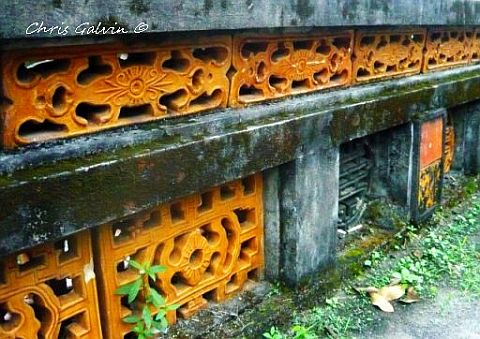
Retaining Wall at the Peace in Four Directions Pavillion
Tu Phuong Vo Su Lau (Pavilion of Peace in Four Directions) was built within the walls of the Hue citadel in 1923 during King Khai Dinh's reign, as a place for members of the royal family to study and relax. The American-Vietnamese war and Hue's notorious wet weather reduced the structure to crumbling and collapsed walls with no roof. About ten years ago, the Centre for Preservation of Hue Ancient Relics restored the pavilion. Much to the disappointment of the public, they then rented it out for a coffee shop.
|
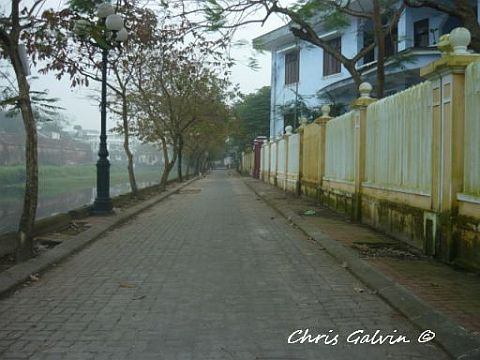
Courtyard Walls 3
I love this quiet road with its yellow courtyard walls by the canal surrounding the citadel. Rather than the busy Tran Hung Dao, I take this route during my early morning walks.
|
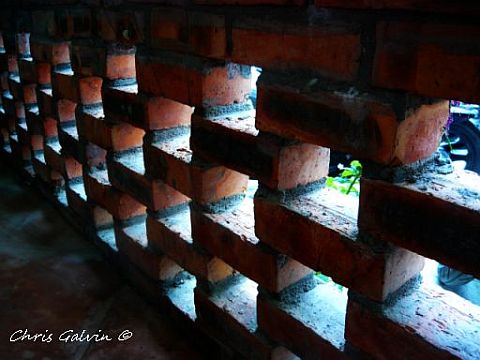
Shadowbox Walls
I am fascinated with the variety of the courtyard walls surrounding cafés and restaurants. This one caught my eye with its shadowbox effect, the lovely play of light and the inviting glimpses of foliage through the openings.
|
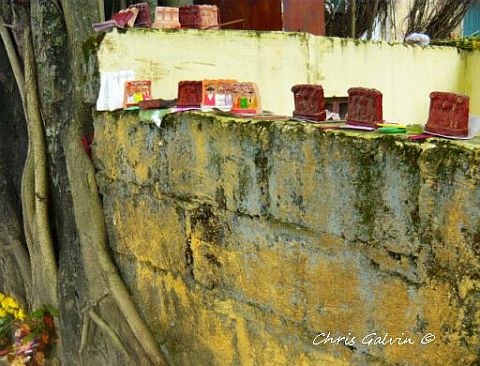
Altar Walls and Kitchen Gods under the Bodhi Tree
This is the wall surrounding the altar at the foot of our bodhi tree, of which a small section of the trunk is visible to the left. All those rectangles on the top of the wall are kitchen god statues. There are more at the base of the tree.
The walled altar is for souls who died away from home during the Tet Offensive of 1968, though not everyone in the neighbourhood agrees. Some say it's for the wandering souls of all important local people who died away from home. Those who can't be given a funeral at home, whether because they were abroad or because they were MIA, as well as stillborns and babies lost by miscarriage, cannot be honoured with an altar inside the house. Hence there are outdoor altars everywhere in the country. Nestled in niches of the gnarled trunk of our tree are several small altars for people who died in traffic accidents nearby and for other souls of this neighbourhood.
On the 23rd of Tet, a week before the Lunar New Year, the kitchen gods fly up to report to the Jade Emperor about each family's activities in the past year. We clean their altar and put out fresh golden chrysanthemums, and mangos draped with votive money to encourage them to give a good report for our family, ensuring that the coming year will be a good one.
According to legend, the gods leave at midnight. A few hours later, before the break of dawn, my father-in-law burns the offerings. Each year, the old statue in the kitchen is replaced with a new one. We place our miniature kitchen god statue on a clean plate and bring it out to the altar under the bodhi tree by the river. All day, people in our neighbourhood do the same, and the collection of statues, old flowers and altar decorations under the tree keeps growing.
|
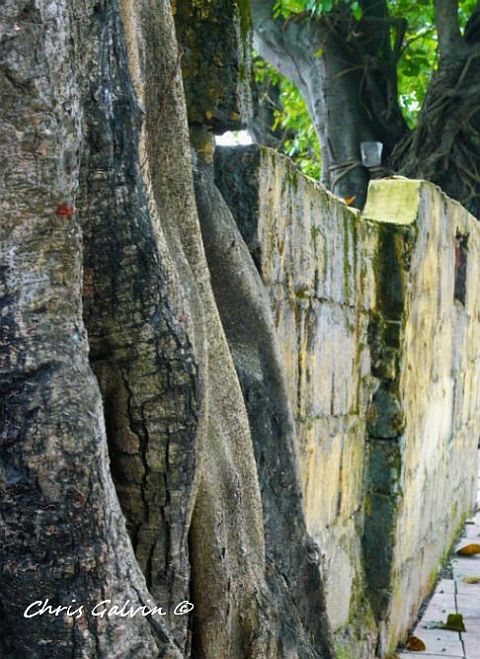
Altar Walls Under the Bodhi Tree 2
|
|
Chris Galvin
is a Canadian writer, editor and photographer with one foot in Canada and the other in Viet Nam. Chris's work has appeared in various Canadian, Vietnamese and other literary and travel magazines and anthologies.
Some of her most recent publications include: Breakfast under the Bodhi Tree – an essay about living in Viet Nam (and also the title piece from her forthcoming book), in the Food and Drink Issue of PRISM International; a photo set to accompany the essay, on PRISM International' s website; and Life with M. – about moving in with her Vietnamese grandmother-in-law, in the 2012 Writers Abroad anthology, Foreign Encounters. Stories are forthcoming in Descant, ImpossibleSpacesAnthology, and Dac San Van Lang Boston. For more, visit her blog.
.
|
|
|









